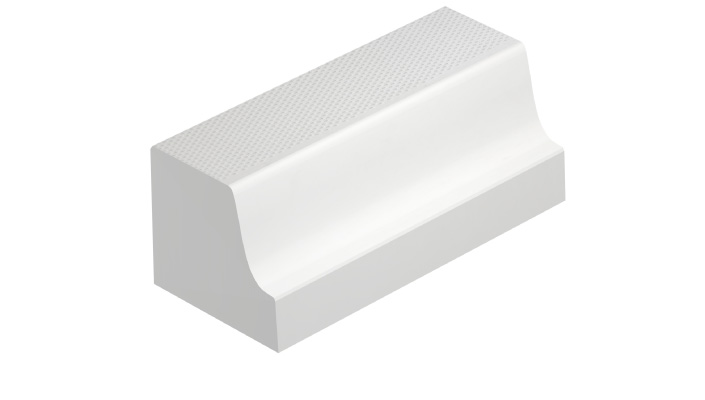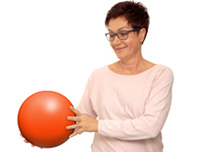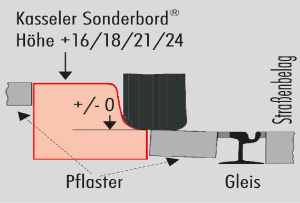The Kassel Kerb®: The extra special raised kerb
The solution for bus and tram stops without barriers!
Bus and tram stops have far-reaching influence on the attractiveness of public transport. One important attribute is accessibility. Unhampered access to buses and trams makes their use more attractive, more comfortable and safer. Not only for the mobility-impaired, but also other people whose mobility is restricted, such as the elderly, parents with prams and small children, benefit from stops equipped with the Kassel Kerb® from Profilbeton. “Barrier-free accessibility benefits everybody, not just the mobility-impaired […] After all, we have to realize that we will all age and that more and more elderly people will also be using public transport,” says Prof. Dr. Hartmut Topp, director of the Transportation Department at the University of Kaiserslautern.
That’s why we dedicate ourselves and all of our resources to this topic. Our experience in Germany and in our European neighbours has made us the authority in this field. Our advice is sought after even at the planning stage. We provide the expert assistance you need to plan and realize your projects.
The Kassel Kerb® forms an important element of the stop/vehicle interface at the planning stage of barrier-free bus and tram stops. Its strikingly bright colour fulfils the requirement for a conspicuously marked kerbstone. The optimally reduced distance between vehicle and stop makes boarding comfortable and safe for everybody.
The use of public transport will become more attractive and safer for all passengers, in particular for the mobility-impaired and for children.

The raised kerb for safe and direct approach
The patented profiled kerbstone from PROFILBETON is the optimal solution for modern low-floor systems.
The profiled kerbstone is one component of the modern low-floor public transport system and unites the low-floor stop with the low-floor vehicle. The height and width proportions of the kerbstone match those of low-floor buses and trams. The kerbstone serves as an approach aid for the vehicle and has the effect of directly guiding it automatically and safely to the stop. The vehicle can be boarded and deboarded easily as the horizontal and vertical distances between the low-floor vehicle (bus/tram) and the stop have been reduced to a minimum.
The approach surface of the profiled kerbstone is similar to the profile of the tyre and is particularly smooth. This is easy on the tyres and reduces their high replacement costs. The kerbstone cannot be displaced; even when driven at directly it cannot be dislodged from its position, as the bus will already be on top of the kerbstone and exerting the load onto it before the flank forces can take effect. It cannot be driven up on or climbed if approached tangentially.
With our raised kerb, you build a durable, low-maintenance bus-stop edge. They also display an innovative, far-sighted design for the modern low-floor system.
Small distance between the raised kerb and bus/train
A low-floor system is a series of passenger-oriented elements both in the low-floor vehicle and in the matching topography of the stop.
The term has become a synonym for innovation and for improvements in the public transport service, in particular for mobility-impaired passengers. The system was initially developed for tram systems but was quickly adapted for buses, with the aim of creating the same conditions for them.
Ground indicators as a tactile boundary with the carriageway
Visually impaired passengers appreciate the tactile surface as it forms the boundary to the track.
The raised kerb for rail and/or bus stops
The horizontal and vertical distance is of great importance for comfortable boarding. The Profilbeton profiled kerbstone achieves the optimal distances between the vehicle and the stop and can be used for both combined bus and tram stops and for dedicated bus or tram stops.
“The striking simplicity results from the ability of the stone to more or less stabilize itself- […] The stone guides the bus such that the gap stays small and manageable for wheelchair users,” says Prof. Dr. Hartmut Topp, director of the Transportation Department at the University of Kaiserslautern.
The Profilbeton profiled kerb is the ideal approach aid for all low-floor vehicles.
Less Wear and a Shorter Duration of Stay
The cross section of the profiled kerb matches the bus tyre profile. The kerbs have been designed to guide the bus safely to the stop by means of a self-steering effect, without driving against or climbing up on it. The smooth approach surface, matched to the bus tyre, is easy on the tyre and reduces replacement costs. Furthermore, the kerb has been prepared such that it cannot be displaced by an approaching bus, as the bus will already be on top of the kerbstone and exerting the load onto it before the flank forces can take effect.
This reduces tyre wear considerably compared to conventional concrete kerbs. “We have seen reductions in sidewall damage of up to 40%,” says Volker Schneider, head of the vehicle and bus department at the KVG Kassel.
The boarding and deboarding rates have been demonstrated to speed up passenger rotation and enable a shorter duration of stay at the stops.
Driving up on the profiled kerb’s concave approach surface reduces the horizontal and vertical distances between the vehicle and the stop, thus producing ideal conditions for barrier-free boarding and deboarding.
Technical advice - we add a personal touch:

Tel. +49 5682 - 7386 - 25
angela.michel[at]profilbeton.de

Tel. +49 5682 - 7386 - 26
barbara.pinto[at]profilbeton.de













